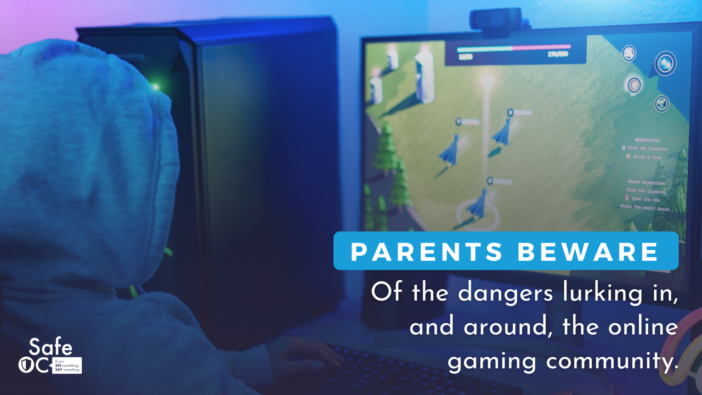To say online gaming is ever-present seems to be an understatement. According to the Entertainment Software Association, 227 million Americans play video games. Worldwide, an estimated 2.7 billion people are gamers. In 2019, video gaming was a $59 billion industry, boosted in large part by children and teens, who were confined to their homes during the pandemic.
Wherever games go, kids are sure to follow, and wherever they go, there are dangerous pied pipers in the weeds seeking to take advantage.
To combat these dangers, groups like SafeOC have released guidelines for parents to combat the dangers of online gaming.
SafeOC is a localized version of the Department of Home Security’s national “If You See Something, Say Something” anti-terrorism public awareness campaign, founded on belief that an alert public plays a key role in keeping Orange County safe.
Donna Rice Hughes, an internet safety advocate and President and CEO of Enough Is Enough has made something of a mantra out of the saying, “predators prey where kids play.”
From pedophiles to cyberbullies to hate groups, from internet fraud to privacy violations, a host of dangers and dangerous people lurk in and around the online gaming community.
In 2021, the FBI began a campaign called “It’s Not a Game” that included a PSA to warn parents about the dangers of gaming platforms and to encourage them to engage with children about what they are doing online and who they’re talking to.
A report by the Anti-Defamation League found 62 percent of young gamers reported experiencing abuse and harassment while playing games online, which represents over 14 million young people.
Constance Steinkuehler, a Belfer Fellow with the ADL and Informatics Professor at UC Irvine, says numerous social platforms for gamers have become homes for “toxicity and harassment,” that many children see and engage in with little regulation.
“There is a dog piling of terror in a primary space for youth to engage,” she said.
Here are some of the dangers that can lurk behind the fun of online games.
Cyber bullying
For all the anonymity and escapism online games provide, not to mention the opportunity to do some harmless virtual bad-ass butt-kicking, it’s a door that swings both ways. While some good-natured trash talking may be commonplace, it can also spiral into something else altogether.
Cyberbullying can be found across the internet, but in competitions where there are winners and losers, it can be particularly fierce. Because youngsters and teens attach so much self-worth, esteem, and identity to their gaming, being bullied can be particularly harmful and profoundly affect mental health.
“Along with other risk factors, bullying can increase the risk for suicide-related behaviors. Furthermore, cyberbullying can be relentless, increasing the likelihood of anxiety and depression,” according to Stopbullying.gov, a website of the U.S. Department of Health and Human Services.
Within the gaming community there is a laundry list of tactics employed to abuse others, including; “griefing,” “kill stealing,” “whispering,” and “doxing.”
Griefers, or toxic gamers, are described as bad faith players, who can destroy something another player has built, gang up with others to take away another person’s accomplishments or block lower-level players from advancing or killing their character.
Bullies will engage in “whispering,” where they flood global chat channels with derogatory comments about their victims, or “doxing,” where they release a victim’s personal information online.
When that happens, it’s no longer just teasing or practical joking.
Kathy Hatem, Director of Communications for Enough Is Enough, says online games are designed for “drawing the whole person into a space” to the point where the virtual world can seem as real as the physical one.
“With that comes the chance that (youths) can be groomed and manipulated,” she said.
In addition, Steinkuehler notes, “Being a victim increases the odds of becoming a perpetrator.”
Most games allow players to “block” chats and messages from other users. Often the bully’s words and actions are a violation of the game’s terms of service. And although all social platforms are supposed to regulate use and behavior, enforcement can be remarkably lax, and there are countless third-party platforms available which have less monitoring.
In 2020, according to a National Center for Missing and Exploited Children report, a record-breaking 21.7 million reports of suspected child sexual exploitation cases were made to that group’s CyberTipline, a 28 percent increase over 2019.
However, 21.4 million of these reports were from electronic service providers. So, while providers may be doing a better job of tracking potential abuse, the continued explosion of reports suggests ineffective enforcement.
“There’s a lot of verbiage but not a lot of enforcement,” Steinkuehler said.
Online Predators
Predators and pedophiles on online game platforms have become enough of a hot button to spur the FBI’s involvement. Although statistics are hard to come by, and many fault makers with inadequate policing and record-keeping, the anecdotal evidence is chilling.
In recent years, according to the FBI, a child predator from Fresno, Calif., coerced and enticed an 11-year-old boy to produce child pornography after meeting him while playing an online video game.
In another case, a Florida man used a popular game to recruit a teen to engage in sexual activity and produce pornographic photos and videos of herself. Investigators believe he may have had up to 20 additional victims.
“In the case of online predators, the process is so deliberate and methodical,” said Hatem.
According to Internet Safety 101, predators often pose as fellow teens or youths to build trust and form bonds and shared online experience, in effect pretending to be the child’s defender, teammate and ally. From this they entice them to venture into more personal territory and may try to isolate children from parents and real-life friends. Often the relationship turns coercive or threatening.
In an interview with Virtru Live, Rice Hughes said the pandemic was “the perfect opportunity for sexual predators to prey, and they did and they still are.”
“These virtual spaces are essentially hunting grounds,” Mary Anne Franks, a professor at the University of Miami School of Law and president of the Cyber Civil Rights Initiative, a nonprofit group dedicated to combating online abuse, told the New York Times.
Also worrisome is that many games have become hypersexualized and border on pornography that is often embedded in games, allowing kids to engage in virtual or simulated sex to earn points.
Name any popular game and there is very likely a pornographic offshoot. These games are often free and easy to access for kids.
Extremism and hate
Another subset of the criminal world has found a home in the online gaming space.
According to the United Nations Office on Counter-Terrorism, in a December 2021 report, “Terrorists and violent extremists are increasingly exploiting this expanding space to recruit, fundraise, radicalize, and disseminate extremist propaganda to vulnerable youth.”
Games have been used by extremist groups to spread misinformation, disinformation and hate speech.
“Misogyny and white-supremacy are circulated with total impunity,” Steinkuehler says, adding that “a generation of youth is witnessing it.”
According to a presentation to the U.N., hate and extremist groups have “created new games, modified existing games and are exploiting gaming culture by embedding rhetoric and messaging used to recruit and promote violent extremism in the gaming space.”
An example of game modification: a group was able to take the popular Sims series and convert it to replicate the 2019 terror attacks on two mosques in Christchurch, New Zealand, that killed 51.
There are efforts underway in Europe, such as the Extremism and Gaming Research Network in England and the European Commission’s Radicalization Awareness Network, but there remains a lack of global policy or programming to address and study the connection between gaming and radicalization.
In the United States, gaming is mentioned amid internet platforms to be addressed in the White House’s National Strategy for Countering Domestic Terrorism.
According to that report, “Recruiting and mobilizing individuals to domestic terrorism occurs in many settings, both in–person and online. These activities are increasingly happening on internet–based communications platforms, including social media, online gaming platforms, file–upload sites, and end–to–end encrypted chat platforms, even as those products and services frequently offer other important benefits.”
To be fair, there are gaming networks and platforms that speak out against hate speech and violence.
Identity leaks/fraud
Cyber criminals aren’t necessarily out to terrorize and bully kids. Most are just thieves. Crooks often single out children on general chats trying to gain information, even identities, that can be pieced together to create new accounts.
Often the game makers use deceptive practices to lure the unsuspecting. A popular trick is playing in a game that is free (freemium) at first, but requires in-app purchases, for added features and full game capability. These have become big business on mobile games. Usually these games require users to attach a credit card to their gaming profile.
Hackers have been breaking into webcams since they were first offered as peripherals and continue today with internal cameras and microphones. Both are vulnerable to being remotely controlled by attackers and used to exploit kids.
Recently the World Health Organization (WHO) added gaming disorders to those “due to addictive behaviors,” adding it to alcohol, drugs, gambling. There has been strong disagreement about the addition, but concern is high enough that China introduced rules that limit the amount of time under-18s can spend on video games to three hours a week.
Protecting you and yours
At the end of the day it falls on parents to protect their children and be the first line of defense. Parents need to talk to children about safe online usage and build upon it as they grow. For many parents that will require learning, maybe a lot of learning. Dozens of sites can be found that parents can browse and share with their children. While it may be time consuming and even confusing, consider the stakes.
“You have to be involved and build trust so your child comes to you,” Hatem said. “Be aware, do your homework and be involved with your child.”
Many experts suggest parents learn to play the games with their children. This allows them to see first-hand what goes on in the games and on the various platforms and forums. It also is a great way to bond with children and get to know their world, especially if the parent isn’t a gamer.
“Until a parent gets online to view their child’s online activities it is hard to know what (children) are exposed to,” Hatem says.
If you purchase a game console or download a gaming app, learn about the product and set parental controls and security settings. Although companies have terms of use and other warnings in their literature, they often arrive with minimum safety settings turned on.
“It really is backwards that it’s the parents’ responsibility to make sure online games are safe,” Hatem says. “That’s why we’re calling on tech companies to be accountable and make sure safety features are defaulted to “on” right out of the box.”
Parents should check out the Entertainment Software Rating Board (ESRB) ratings of games. These rate games in four categories; from games for everyone, to those for mature users. Parents should approve all their children’s gaming and downloads.
Use cybersecurity software that can regularly scan for malware and other intrusions. As in any online forum, never give away any personal information, and be sure to vary usernames and passwords across games, platforms, and accounts.
Most important, if you See Something, Say Something. Parents and children should contact law enforcement immediately if they suspect abuse. The National Center for Missing and Exploited Children has a cybertip report where reports can be made and where victims can be referred for help.
 Behind the Badge
Behind the Badge




